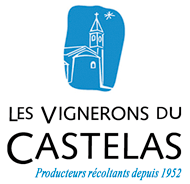TECHNOLOGY AT THE SERVICE OF LES VIGNERONS DU CASTELAS
The Reception
The winery of Rochefort du Gard is equipped with two stainless steel reception conquests fitted with large diameter worms allowing direct supply of the destemmer with a constant and optimized flow while preserving the harvest. The reception conquest is the last moment to check the condition of the harvest.
The Flash détente
The flash détente is a wine-making process obtained by vacuum treatment of a fresh harvest which has been brought up to temperature. This process promotes the extraction of compounds from the grape berry. It can be related to the high temperature vinification technique.
The harvest must first be trodden and destemmed. It is then reheated by passing through a hopper with a pierced cylinder. These holes allow the steam to reach the heart of the harvest to heat it as quickly as possible between 85 and 90 ° C. The heated harvest is then sent to a reinforced tank at partial vacuum by a volumetric pump system. This partial vacuum process makes it possible to weaken the pectocellulosic walls that make up the cells of the grape berry for a simpler extraction and at the same time to lower the temperature of the harvest.
At this moment, the so-called "flashed harvest" is sent to the press for the extraction of the skin compounds which will give the color to the wine, then in a maceration tank. A phenomenon of separation of the seeds from the pulp and the skin due to the flash relaxation process makes it possible to remove the hard tannins from the seeds. The Flash détente process is followed by a maceration lasting 12 hours to 8 days which is characterized by a very concentrated color. This technique is a thermo-treatment process not to be confused with the high temperature vinification .
The Pressoirs
Les Vignerons du Castelas are equipped with two pneumatic wine presses with a capacity of 150 hectoliters (15,000 liters) operating with air, with a pressure of up to 1,800 bars. These devices are used in the pressing of the grape berry to extract the grape juice, also called "grape must" or "vin nouveau" after fermentation. This extracted juice still contains the grape marc and will become by different vinification processes the wine we know.
The Cold Group
The vinery of Rochefort du Gard is equipped with a cold unit allowing the mastery and control of vinification temperatures by means of flags.
The refrigeration unit produces cold and transmits it thanks to an exchanger with integral flow of heat transfer fluids to flags located in the tanks. The system is a rigid and sealed circuit allowing the wine to be cooled and kept at temperature without thermal shock , no mechanical effects harmful to the quality of the harvest. The shape of the flags in the tank does not present any resistance during the devatting stages, or during the formation of the skins at the top of the tank.
Tangential filter
Tangential filtration is a process used by Les Vignerons du Castelas to separate the particles that make up a liquid by size, in our case at the vinery of Rochefort du Gard: wine.
In practice, a filter is generally used in the front position, that is to say that the flow of wine is perpendicular to the filter. In the case of a tangential filter, the flow of wine is parallel to the filter. It is the pressure of the wine that allows it to pass through it. Small particles pass through the filter while larger particles remain in the flow.
One of the advantages of the tangential filter is that it automatically cleans itself due to the pressure of the flow on the membrane, thus reducing the frequency of replacement.
Tangential filtration is designed for the separation of very small particles on the order of nanometers to micrometers.





